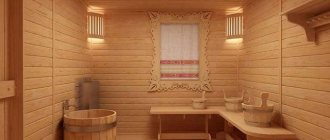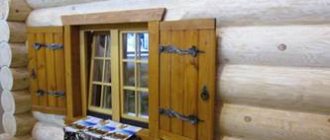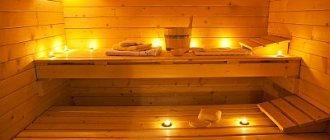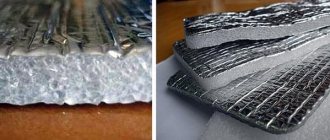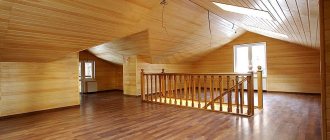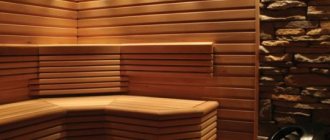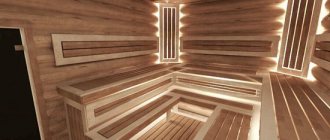Briefly about the main thing
To process lining in a bathhouse, materials that are resistant to temperature changes, humidity, and washing are used.
Also important is inertness to fungus, mold, bacteria, and a safe composition for humans. When heated, many materials release toxins and other harmful substances, so the use of antiseptics, fire retardants, drying oils, varnishes with solvents and acrylic resins is unacceptable for the steam room.
For walls and ceilings, impregnations, mastics, oils and some varnishes are used. For shelves only oil or wax based formulations. This prevents the formation of a thick film to avoid burns.
Bleach is used in any room of the bathhouse, but before further processing of the wood, it is necessary to wait until the chlorine evaporates and the hydrogen peroxide decomposes.
Antiseptics and fire retardants are classified as pre-treatment agents for wood, but are not used as independent coatings. They protect the lining and help reduce the consumption of the finishing coating.
Why paint the outer surface of the bathhouse?
The wooden frame of the bathhouse retains heat for a long time, making it comfortable to be in. However, natural materials definitely need protection.
Painting the outside of a bathhouse is an important condition for extending its existence. Sun, wind, rain, frost contribute to the destruction of wood. Temperature changes inside the bathhouse also have a negative impact. Wood-boring beetles damage unprotected surfaces.
In addition, the painted structure has an aesthetically attractive appearance. Designer imagination can fully manifest itself even in such a simple room as a bathhouse, making it a real work of art, the pride of the owners.
Particularly vulnerable materials that need painting are timber and logs.
Types of coatings
The wood in the bathhouse is coated with paint to reduce exposure to moisture and high temperature.
The steam room and washing room are subject to the greatest load. However, this load is different.
- In a sauna, the air temperature can rise to 110°C. However, the humidity here is low. Paint for such a room must withstand heat, but may be sensitive to water.
- In the steam room, the humidity is much higher - from 70 to 100%, depending on the type of bath. The temperature is noticeably lower – it rarely rises above 60°C. The finishing material must be resistant to both water and steam and temperature changes.
- In the washing room, the temperature is not higher than a comfortable +30°C, but the humidity here can be high - 90–100%. The paint chosen is as waterproof as possible.
In practice, painting the inside of a bathhouse, especially a log house, is not a good idea. Any paint will be less resistant to the above factors than the wood itself. But if there is no other way to protect the finish, they also resort to painting.
Oil impregnations and varnishes
Effect of oil impregnation against moisture
A bathhouse is a structure used with a certain frequency. The high temperature in the steam room is maintained only during the procedure. Then the room is specially ventilated, cooling to a low temperature.
In this mode, the boards are more likely to dry out and become covered with cracks rather than mold and rot. Therefore, oil impregnations and varnishes are best suited for treating the steam room.
The oil penetrates the top layer of the wood, forming not a film, but a structure impenetrable to water. At the same time, the wood continues to expand normally and decrease in volume as the temperature changes. This way the oil prevents cracks from appearing.
Antiseptics for bath floors
The floor in the bathhouse is covered with antiseptic impregnations against rotting.
It is not enough to paint the steam room or sauna in the bathhouse - you need to take care of protection from rotting. The weak link in this room is the floor. Water flows onto it, steam is deposited, and it comes into contact with a cold concrete base or soil. To prevent the wooden floor in the bathhouse from rotting 5-6 years after construction, it must be treated with antiseptic impregnations.
Liquids based on substances that have a disinfecting effect:
- Acrylic-based water-based compositions. Moisture-resistant, prevent the growth of fungus, but are not very effective. More suitable for processing the dressing room.
- Organic – based on oils. They are better absorbed by wood and are moisture resistant.
- Products based on wax and urethane oils are absorbed to great depth. In addition to the water- and dirt-repellent effect, they give the timber and lining velvety and softness.
- Combined compositions increase both water resistance and fire safety.
It is strictly forbidden to use compounds that release toxins when drying to treat wood.
Water-dispersed impregnations
Acrylic paints reduce the harmful effects of moisture on wood
You can paint the logs inside the sauna or steam room with water-soluble paints.
The floor and walls in the steam room are painted with water-dispersed acrylic paint. It is quite resistant to temperature changes and does not prevent the penetration of steam. The hiding power is usually low, but the wood can be given any color. The downside is its low durability, the paint washes out quite quickly.
Paint for a bathhouse in a washroom should be as resistant to water as possible. The best products are latex or polyurethane based. For a dressing room or rest room finished with plaster, you can use any compositions marked “for interior decoration.”
The paint forms a film coating on the surface of the wood. And oil compounds penetrate inside, so in the steam room the walls are treated with impregnations.
Wax-based impregnations
Wax paint does not allow moisture to pass through, so it is well suited for baths and saunas
Wax is offered in liquid - viscous composition, and solid. The latter is somewhat more difficult to apply without the habit, but the treatment is carried out less frequently. The product does not create a sticky film and does not attract dirt.
If you only need to protect surfaces from water and steam, wax is more suitable. It is transparent, does not hide the structure of the wood, has some antioxidant activity, and therefore prevents the darkening of the wood.
Water-based polyurethane varnish
This is a kind of resin solution, where water, ethanol, and ether are used as a solvent. For the bath, choose water-soluble varnishes. They are resistant to high temperatures and to acids, oils and salts.
Polyurethane varnish is wear-resistant. Since it is based on water, the varnish layer does not create increased tension on the surface of the wood, and therefore is not prone to cracking. And since the resins polymerize already during drying, there is no subsequent peeling.
Protective compounds and their properties
For the sake of order, it is necessary to mention such a remedy as drying oil, which used to cover all the insides in the bathhouse. It is still used today, but it should not be used in a steam room. It will be cheap, but cheerful. In terms of protective properties, this is yesterday, and the smell from it when heated well is not pleasant.
Water-dispersed impregnations
They are made on a water basis, so they penetrate deeply into the wood structure. They are resistant to high temperatures, do not contain active chemical components and do not emit any harmful compounds when heated. Modern water impregnations contain antibacterial components. Available both colorless and with added dyes.
The disadvantage is their fragility. Over time, under the influence of water, they are washed out of the wood, so the impregnation must be renewed every two years.
Oil impregnations and varnishes
They impregnate and protect wood well from moisture, forming a film. But their inherent smell is a significant drawback. Therefore, they must be used with caution in the steam room. They are quite suitable for external impregnation and for protecting wood in the dressing room.
The varnish preserves the appearance of the wood, giving it a mysterious shine Source freepatriot.club
Acrylic based varnishes
Acrylic varnish for baths inside is considered safe. A modern product made from polyacrylates and organic solvents. Environmentally friendly and more durable than conventional water-dispersed products. Acrylic varnishes produced for baths and saunas necessarily contain antifungal components.
Water-based polyurethane varnish
Combines the advantages of water-dispersed and alkyd varnishes. It appeared on the market relatively recently, so it should be treated with caution, as with any new product. And its price is quite high.
Wax-based impregnations
Wax, like drying oil, has long been used to protect and add shine to wooden surfaces. Nowadays purely wax impregnations are almost never used. It is common practice to add wax to protective products based on other components.
In addition to protective products, special detergents are also produced for cleaning and bleaching wood. They are used both before applying protection and for washing dirty and darkened surfaces.
Types of premises
Fortunately, there are not many rooms in the bathhouse (in a standard one). Therefore, we will quickly go through the options of what paint to paint the inside of the bathhouse.
Steam room
This is the most problematic room. Many people believe that there is no need to paint anything there at all, but the price for such a decision is rapid darkening of the wood (and almost everyone has a steam room traditionally made of wood or lined with wood), cracking of the wood (this happens more often from poor ventilation during drying), susceptibility to rotting and mold damage (linden and aspen are very unstable species).
So the absence of any protective coatings, on the one hand, should be considered environmentally friendly, and on the other, costly in terms of future repairs.
You can paint the inside of the steam room with both paints and varnishes, but let them be water-soluble paints. And it would be nice if the label mentioning GOST standards stated that this composition is applicable in the steam room.
Washing
Both silicone and acrylic paints are suitable here. In general, everything that patiently endures the effects of moisture.
Other paints will crack and peel off in pieces under constant exposure to water.
ADVICE! Water dispersions do not tolerate frost well: if the water in the paint freezes, then after defrosting it will lose its quality. Therefore, buy them in the warm season, produced recently.
Impregnations and varnishes are also suitable for painting washing areas.
Again we draw your attention to scuba gear
Of course, in the second case, it is better to paint when it is possible to ensure the best ventilation and the absence of people. Don't forget to use respiratory protection.
IMPORTANT! Remember that enamels and alkyd paints are fire hazards, but water-soluble paints are not.
Choosing what to paint the outside of the bathhouse with
In that article we talked about what paints are suitable for painting the inside of bath rooms. Here…
Materials for a bath, Materials for a bath inside, Materials for finishing a bath, Painting, Impregnations · 09/23/2018 · 2
Requirements for decorative coating
When choosing paint for decorating the interior of a bathhouse, you should take into account that this material must meet the following requirements:
- protect the wood surface from the effects of aggressive environments that occur in the steam room and dressing room;
- withstand exposure to high air temperatures;
- maintain the integrity of wood and extend its service life;
- provide treated surfaces with an attractive appearance.
Remember that the time during which you can use the bathhouse without major repairs depends on what you paint the inside of the bathhouse with.
In addition, the following factors must be taken into account:
- the type of wood used;
- the ability to perform additional coloring;
- surface condition before treatment.
Special materials should be used for surface treatment
For those craftsmen who have not yet decided how to paint the inside of the bathhouse, it should be noted that most often special varnishes with special properties are used for this purpose:
- High coefficient of vapor permeability. This allows you to avoid the appearance of mold, prevents the appearance of fungi and bacteria, and prevents the formation of condensation.
- The ability to apply a new layer without cleaning the surface from the previous one.
- The presence of pigments that emphasize and highlight the natural texture of the wood with which the steam room and dressing room are decorated.
If you are not satisfied with varnish, acrylic bath paint is an alternative: you can use water-based mixtures inside. Considering the resistance of acrylates to low temperatures, this same type of decorative finish can also be used for facade work (the instructions for use confirm this).
Photo of a steam room whose walls are varnished
The advantages of paint over varnish include a large range of colors and a long service life of the decorative coating.
Tips for choosing a topcoat and interesting ideas
A wide selection of coatings allows you to choose absolutely any color and texture for the lining. In a country house, it is better to give preference to the most durable and unpretentious compositions that do not have to be updated frequently.
If the finish is new, then it is worth preserving its natural color and choosing transparent products for processing: varnishes, azures.
If the panels have many defects or an old coating, then thick, opaque paint is indispensable. You can improve the appearance of the base surface by removing the top layer of wood, but this is too labor-intensive and time-consuming.
Unusual combination of paint shades for lining
The colors and shades of the lining can be combined in the decoration of one room. This technique allows you to divide a spacious room into zones. Decorate or diversify the design, place accents.
Color accents in clapboard finishing
Due to the color of the finish, you can achieve some visual effects. Light shades expand the space, dark shades, on the contrary, make it smaller. The white ceiling looks higher than the brown one.
The color scheme for the lining can match the palette of shades used in the interior or contrast.
Harmonious combination of color palette of textiles and walls
Choosing paints for concrete floors
There are four types of paints used to paint concrete floors: acrylic, epoxy, acrylic-silicone and alkyd-urethane.
Acrylic
Such paints are resistant to water and temperature. Paint for concrete floors makes the surface matte, semi-matte and glossy.
To dissolve acrylic paints, use plain water and acrylic thinners. The painted surface is ready for use after 48 hours.
This type of floor paint should not be used on concrete floors that have previously been painted with epoxy or polyurethane products.
Epoxy
Two-component paint compositions are mixed with a construction mixer before starting the painting process.
Before using paints, the floor is treated with a primer - an epoxy compound diluted 25% with ordinary water.
Complete drying is achieved after 7 days, but the surface can be used within 24 hours. Concrete floor paint has a limited range of colors.
Alkyd-urethane
The materials are distinguished by a high degree of concealment and require painting the floor in several layers. Concrete paint is resistant to rapid abrasion and temperature conditions. White alcohol (15%) is used for dilution.
The paints are distinguished by a wide palette of colors and an attractive gloss of the painted surface.
Oil based paints
A classic, proven method for treating walls outside the house. Oil paints have the following advantages:
- absorb into the surface, guaranteeing protection against moisture penetration;
- resistant to temperature and humidity changes.
Painting of this type also has some disadvantages, which are often not considered significant, rather falling into the category of the natural state of affairs.
- The compositions dry for a very long time - from 8 hours to several days. Therefore, sticking midges and dust contamination are possible. In addition, there is a risk of precipitation and changes in the surface of the paint due to exposure to water.
- Over time, the paint surface becomes dull and the color changes. This is especially noticeable for the extreme segments - dark and light color shades.
However, in general, oil-based paints are very functional. They are cheap, do not require special application methods, retain their characteristics for quite a long time, and almost everyone can paint using standard methods.
Oil paints are a traditional medium for coloring.
Features of choosing a coloring composition for a bath
The difficulty of choosing is due to temperature and humidity. The heat is much stronger in the room closer to the ceiling, and with strong heating, as mentioned earlier, coloring pigments release toxic substances into the air.
Therefore, in a steam room, it is advisable to treat the ceiling and upper part of the room with impregnations. Like paints, they differ in their composition and release form; they can be water- or oil-based.
Before purchasing, it is important to determine the area where it will be used (ceiling, floor, walls, etc.). The choice is also influenced by subsequent processing, namely, whether the surface will subsequently be covered with a decorative layer or not. The next factor is ease of application, as well as the degree of moisture protection. The optimal product is considered to have good moisture-proof and steam permeability properties.
In the steam room, it is advisable to treat the ceiling and upper part of the room with impregnations.
Selection of paint and varnish materials for interior work
Requirements for coating materials vary depending on the processing area. The steam room is considered the most problematic place. Oil-based coatings better penetrate deep into the natural structure of the material, prolonging its service life, but at the same time they are characterized by increased toxicity and an unpleasant odor due to the presence of solvents in their composition. They are ideal for treating the outside of walls, as well as the dressing room.
Water-soluble impregnations are suitable for this area. They are based on acrylic, and an additional component is color, which gives the surface a particular shade. This impregnation can be used to treat the structure both inside and outside. However, despite all the advantages, acrylic compositions have a significant disadvantage - over time they are washed out of the wood structure.
In order for the surface to retain its properties for as long as possible, it is necessary to paint it periodically. Another option is to apply a waterproofing compound first and only then impregnation.
How else can you paint a bathhouse inside a steam room? Instead of drying oil, you can use paraffin oil or any other composition intended directly for the steam room. This oil is distinguished by its safety for health while maintaining characteristics similar to drying oil.
In the bathhouse, surfaces are treated with impregnation several times a year.
In order for the surface to retain its properties for as long as possible, it is necessary to paint it periodically.
The least heating zone in the steam room is the floors. Therefore, the answer to the question of how to paint the floors in a steam room in a bathhouse is quite simple - any oil impregnations or acrylate compounds. For wooden floors, you can use water-based varnishes, which do not have an unpleasant odor and are much easier to apply. When choosing a water-based varnish, it is better to give preference to European manufacturers, since the quality of these particular products is much higher.
You can often find concrete flooring. This coating must be painted. Epoxy, polyurethane and acrylic mixtures are suitable for this.
For wooden floors, you can use water-based varnishes, which do not have an unpleasant odor and are much easier to apply.
How to paint lining like bleached oak
Often it is necessary to paint the wood white, but so that the veins are visible. They also say to create the effect of bleached oak. There are several ways:
- Use tinting with the appropriate name, which is also called stain. Different manufacturers have these. They usually have the names "frost", "bleached oak" or something like that. Application feature: do not pour too much composition. If you overfill it, the surface will begin to peel off over time. To achieve the desired degree of coloring, apply several very thin layers. After each, give it time to dry thoroughly.
- Oil with wax with a similar name. The application technique depends on your desire: one or two layers for an almost opaque coating, or one layer followed by rubbing with a rag for a pronounced texture.
- Pigmented polyurethane primer called “white” or “bleached”. To obtain a translucent coating, the composition is diluted with a large amount of thinner. Its amount can be 80-100% of the volume (determined by samples). The disadvantage, like all polyurethane paints and varnishes, is that they turn yellow over time.
- Pigment acrylic primer, also diluted by 80-100%. The color remains white for a long time, but this primer costs more than polyurethane.
It’s difficult to say which composition to choose - you need to try. It is advisable to paint the lining with several compositions and compare the results. The effect when using different products is slightly different, but it also greatly depends on the wood. The reviews are also very different - some whitened with tinting, others with oil. Soils are rarely used for these purposes, but mainly because not everyone knows their properties.
Features of protection of different parts of the steam room
Of course, you can saturate the entire steam room and the furniture in it with one composition. And then coat it with one varnish. Moreover, the products currently produced are rarely limited to one protection function. They usually combine, for example, impermeability with antibacterial effects. But the conditions affecting different parts of the steam room are still somewhat different. Therefore, the processing requirements are also different.
Ceiling
Perhaps the least requirements are placed on this part of the steam room. It is exposed only to the temperature effects of steam. Water almost never reaches it. Therefore, it can simply be coated with a specialized bath varnish.
The ceiling in the bathhouse must be reliably protected from dampness and temperature Source eco-ceiling.ru
On our website you can find contacts of construction companies that offer bathhouse construction services. You can communicate directly with representatives by visiting the “Low-Rise Country” exhibition of houses.
Floor
Unlike the ceiling, all the water that is used in the steam room ends up on the floor. Therefore, the anti-water protection for floor boards must be very good. In addition to antibacterial and anti-water impregnation, it is advisable to cover the floor with a protective layer of varnish. But not every varnish is suitable for the floor. The protective layer should not be slippery. This is a must to protect the floor. Of course, the soles of your feet should not stick to the floor. Do not think that repeatedly coating the floor with varnish increases its safety. The thick layer of varnish cracks and water reaches the wood. In addition, the wood cannot “breathe” through such a coating and will still deteriorate.
When building a bathhouse, do not forget about impregnating the logs on which the floor boards are laid. This, of course, is not the inside of the bathhouse, and there are no special protection requirements for them. But if water gets to them, then sooner or later the floor inside the bathhouse itself will suffer, no matter how well it is protected.
Walls
Most of the impregnation for the bathhouse inside is spent on protecting the lining, which is usually used to line the walls. Therefore, you should not use impregnations and varnishes that, when heated, can release strong-smelling substances. And do not cover it with a protective layer that does not allow the wood to “breathe.”
Shelves and benches
The shelves are the main part of the entire steam room, for which it is, in fact, built. Lying on it should be comfortable, pleasant and safe for health. Wood is a poor heat conductor, so even at high temperatures you won’t get burned by it. It’s another matter if it is covered with a protective film, which can cause a burn if touched. Therefore, it is not recommended to use paints or varnishes for it. It is better to apply a special impregnation for the bath. Often such impregnations are wax-based.
The requirements for the safety and convenience of the surface of shelves and benches are so high that there are bathhouse lovers who believe that wood should be natural for them and not covered with anything at all. But this is still suitable for small bathhouses, where simple shelves can be replaced. And when real furniture masterpieces are built, it is better to find a high-quality composition and ensure their durability.
It’s not enough to create beauty – it also needs to be protected
Application
Since users often have private questions about the applicability of certain dyes in a bathhouse, we will try to clarify these points without waiting for questions in the comments.
Can the floors be painted?
Can. Moreover, if we are not talking about a steam room or a washing room, you are generally not limited in your choice. But even the steam room and washing room are no exception - if you use specialized dyes or impregnations.
The floor in the steam room is the zone of least heating , and this applies even more to the sauna, because there the air flow is usually through the bottom of the entrance door, and cold air spreads along the floor, cooling it. In a Russian bath, everything is sealed to the maximum, but there and in the working area the temperature is low, so the floors have a low temperature in both cases.
We have already written about whether it is possible to paint the floors in a bathhouse with paint. However, we consider it possible to repeat that all options come down to oil impregnations (the Finns are not afraid that it will be slippery), as well as acrylate compounds (see Tikkurila products above).
In fact, if you want to paint the floor in the steam room and washing room, use the most environmentally friendly compounds - those that dissolve in water . For example, acrylic bath paints mentioned above.
Walls
There shouldn’t be any problems with this at all, because for the floor you still need to somehow select a composition with the greatest wear resistance, and for walls any composition is suitable - paints, varnishes, impregnations, any composition (preferably harmless).
You can read an overview of the options in this article.
How to paint stoves, boilers, tanks?
In general, it is correct that all equipment associated with heating water needs protection from corrosion, and certain paints and varnishes can help with this. You just need to figure out what exactly is suitable for these purposes.
For a metal stove
The temperature in the stove depends on the combustion temperature of the wood. Firewood comes in different types of wood and different humidity levels. Plus, another important point is air access: the more air there is, the higher the flame temperature.
Let’s assume that the combustion temperature, which varies somewhere from 500 to 1000 degrees “ideally” (that is, dry ash firewood, for example, with sufficient oxygen), in reality is 600-800 degrees (if you don’t burn it with poplar) . In this case, you should focus on paint with heat resistance of 650 degrees.
the CERTA already mentioned above, there are other companies that produce silicone enamels. However, few people have high temperature limits. For example, Sniezka can withstand up to 500 degrees. In general, it is worth understanding that on this site we do not promote the products of certain companies, we are more interested in the quality characteristics of the products.
In general, either measure the temperature of the furnace with a thermometer, or somehow be guided by the color of the metal's heat (there are tables where the shade of red is converted into degrees, but, of course, it is difficult to determine the shade by eye).
In addition, there is a useful video that tells you exactly what kind of paint and how much paint you will need in your work:
For boiler
The choice of paint for your sauna boiler depends on what type of fuel you use to heat it. Coal burns at a higher temperature than wood. Ideally - at 2000 degrees, in reality - at 1000. Therefore, the boiler should be painted with paint that can withstand up to 1000 degrees.
For hot water tank
The hot water tank does not heat up above the boiling point of water. Therefore, the paint for a hot water tank in a bathhouse can be exactly the same as that used for painting radiators . Although, if there is anything left from painting the stove, you can use that too.
Surface preparation and painting process
Whatever you paint the steam room in the bathhouse with, first the surface needs to be prepared, and taking into account the material (wood), this process is a necessity. First you need to prepare all the tools and the coloring composition itself. It is advisable to familiarize yourself with the recommendations of the masters. This is especially important to take into account for people who are encountering such work for the first time. Surface requirements:
- The surface shade should be uniform. The heterogeneous structure is degreased;
- Professionals treat the wood with hot drying oil, which helps stop the growth of bacteria;
- Using special equipment it is necessary to sand the surface.
The paint is applied with a roller, brush or spray gun. The last option is suitable for people who have experience working with such equipment. Otherwise, it is impossible to achieve the desired result.
Professionals treat the wood with hot drying oil, which helps stop the growth of bacteria.
Bath painting tools
Experts recommend preparing a roller, brushes (wide and thin), and a spray bottle with a capacity of about a liter. To remove residual dust and dirt from the cracks, use a compressor or vacuum cleaner. To thoroughly sand the ribs and ends of the frame before applying paint, use an eccentric sander.
It is advisable to apply the first layer of paint with a wide brush or roller, treat the seams with a thin one, and apply a second layer using a sprayer. To give the walls a matte shade, use a roller and brushes to make the surface shiny - use a spray bottle.
Also, to safely conduct the event you will need safety glasses, gloves, and a respirator.
Alternative coloring agents for baths
How to paint the walls inside a bathhouse if you don’t want to use toxic substances? Use folk recipes. In ancient times, people used natural substances in the form of oak bark decoction. It gives the wood a dark but natural shade. You can get a fire-fighting composition by mixing starch and ocher.
A combination of flax drying oil and beeswax in equal proportions is also known. To this day, people still use linseed oil and even vegetable oil as impregnation. However, time-tested, natural ingredients cannot withstand any competition with modern industrial drugs.
Oak bark gives the wood a dark but natural shade.
Regardless of the quality of the materials used, experts advise carrying out antiseptic measures by impregnating the wood at least once a year. It is important to follow all recommended actions. For example, despite the “perfect” composition of modern products, none of them will last long if applied to an unpolished surface. The main objective of the coating is not only to improve aesthetic results, but also to extend the operational life of the wood. Therefore, when purchasing ready-made preparations, you need to pay attention to highly specialized paints, impregnations and varnishes intended directly for baths and saunas.
How and with what to treat lining in a steam room - practical tips
Building a bathhouse is a complex process that includes many different tasks. The basis of the bathhouse is a log house, which is additionally lined inside. The lining most often used is lining made from alder, aspen or spruce, which have high strength and resistance to steam and moisture.
However, the natural properties of wood are not always enough. In a bathhouse, wood is exposed to moisture and hot steam, which leads to deformation of the skin. To avoid damage to the wood, it is necessary to additionally treat its surface. In this article we will tell you how to treat the lining inside a bathhouse so as not to change it every year.
Mistakes when painting a log house unqualified
If the desire to save on professional services for some reason outweighs the guarantee of the quality of the work performed, then after a while unsightly results such as stripes, stains and simply peeling areas on a recently painted surface are very likely. In such cases, the quality of the paint product is not always to blame. Unprofessional builders, due to inexperience, make basic mistakes that affect the final result:
- The facade is not properly prepared for painting: poor-quality sanding (or lack thereof) leaves the surface rough.
- painting technology (sequence) is violated
- Work is carried out in unsuitable conditions (high humidity or under the scorching sun).
- Newly erected ( naturally damp ) walls are painted.
- Incompatible materials were selected for painting .
Peeling of paint is caused by a violation of technology Source otdelka-expert.ru
Installation of brick partitions in baths
If you were still in doubt up to this point, check out this list:
- The metal structure heats up very quickly, which does not allow the body to adapt to the high temperature.
- A metal stove cools down as quickly as it heats up. You have to constantly monitor the temperature by adding logs, which is not very economical.
- The material lined with brick will not heat and dry the air so quickly, which means the atmosphere in the steam room will be more comfortable.
- There is a high probability of being burned on the walls of a metal structure. People sitting next to the stove will not feel comfortable.
All these small shortcomings can be easily eliminated with the help of cladding, which will increase the performance of the stove, improve its design and neutralize harm to health, because people go to the bathhouse to improve their health, and not vice versa!
This is the most optimal solution in terms of efficiency and labor costs - to combine the advantages of a metal and stone stove.
At the moment, factories are producing stoves that are initially designed for further lining with brick; this design is the golden mean that will allow you to profitably equip an excellent steam room.
For lining the furnace you need to use only these types of bricks:
- red ceramic brick;
- fireclay brick.
Do not take sand-lime brick. It is great for cladding a house, but it is not suitable for lining a sauna stove. Lime-based bricks are simply not able to withstand constant temperature changes and high humidity in a steam room.
After just a few weeks of use, it will begin to deteriorate. And from a decorative point of view, it is not suitable and additional cladding will still be required.
Fireclay brick
Outwardly, it is, of course, inferior to red ceramic brick, but this issue can be resolved with decorative finishing cladding.
If there are no remaining bricks on the farm, it is better to buy a new one! Give preference to ceramic red brick. Its specific gravity is much lower than that of fireclay. It demonstrates excellent technical properties, reliability and durability. And externally, the stove, lined with red ceramic bricks, will delight you for many years with its stylish, authentic look.
The process of lining a sauna stove with bricks is not very complicated, and if you strictly follow the detailed instructions, even a beginner can handle it.
Brick lining scheme
Painting a brick oven
Preparatory stage: If there are minor defects (depressions, bumps, potholes), first plaster and level, and cover the seams with a clay solution. You can learn how to prepare a good clay solution from the corresponding article, which is on the blog...
Plaster is made from clay and crushed asbestos. The resulting mixture is carefully applied to a well-heated stove.
How to paint: The two most popular proven folk methods are lime or chalk. The third method is again heat-resistant paint, which is also used for iron sauna stoves.
Cooking and painting with chalk
Stages:
- Pour the pieces of chalk into a container (bucket, basin), fill with slightly warm water so as to cover the surface and leave for at least one hour;
- In another container, mix animal glue with warm water in a ratio of 25:1. Animal glues include gelatin, casein, albumin, and bone.
- Mix both solutions and bring to a homogeneous consistency. “To check the quality of the solution, drop it on a piece of glass or mirror placed vertically. If the density is normal, then the droplet will slide down by 2-3 cm.”
- Apply two or three layers. Each subsequent one, only after the previous one has dried. “For a more “clean” whiteness, you can add a tablespoon of blue to a bucket of the finished solution. It will remove some of the yellowness.”
Cooking and painting with lime
Steps:
- Solution proportions: 1 kg of lime / 1.5 liters of water at room temperature / 1 tbsp. spoon of drying oil / 25-30 grams of blue / 1 tbsp. spoon of salt. Mix. “The most durable whitewash is made from freshly slaked lime, and salt is added to make the lime coating less dirty.”
- Apply in two or three layers. Unlike whitewashing with chalk, each subsequent layer of lime whitewash is applied to the wet previous one. “If the stove in the bathhouse was previously painted with chalk, and you intend to use lime (and vice versa), the surface must be thoroughly cleaned of old paint.”
Rules for painting a bathhouse from a log house
If the material for constructing the walls is a log frame, then it is better to use environmentally friendly paints that will ensure its protection from the negative influences of the atmosphere. The materials retain their natural color for many years.
Before carrying out work, you need to prepare stools and stepladders, which will ensure convenient painting at height. Regardless of the material chosen, a person must take care of personal protective equipment. It is recommended to carry out painting with a respirator and gloves.
You need to do everything yourself
It is recommended to do the painting yourself, which will ensure the creation of a beautiful object for many years. When carrying out the procedure independently, a person takes responsibility for all its stages, so there is no formation of mold or rot on the surface.
Preparing a log house for painting
Before painting a timber bathhouse, the surface is prepared, from which dust and debris are removed. Experts recommend rinsing the entire surface with water and a stiff brush. After this, the walls are dried. It is strictly forbidden to apply paint to wet walls, as this will cause it to peel off. If necessary, the surface is polished.
If there are lesions on the surface during grinding, they are treated with a composition with bleaching properties. If there are traces of fungus or mold, you should consult a mycologist. At this stage, all cracks and chips are sealed.
Before applying the paint and varnish material, the surface is treated with a primer. After the product has dried, a second layer is applied. Experts recommend painting with an antiseptic solution to protect the surface from mold and mildew. Before painting, a special agent is applied to the surface to provide fire protection.
After sanding the wood, it is treated with an antiseptic primer solution, which will increase its adhesion to the paint. To apply the primer, use a brush, roller or spray gun. The last option is the most reliable, as it will ensure the penetration of the composition into all recesses and irregularities. After the first layer has dried, the boards are sanded. It is recommended to apply the second layer of the composition only with a spray gun. It is held at right angles to the surface.
End painting
To treat the ends of logs, lime or a product with a similar composition is used. This will ensure that steam moves along the log along the fibers while the logs are in use.
To prepare a lime mortar, take a kilogram of lime, which is first slaked and filled with 1.5 liters of water. Salt (5 grams), blue (25 grams), drying oil (teaspoon) is added to the composition. Thanks to the use of blue, whitewash acquires a bluish tint. It is recommended to apply the solution in several layers. The next layer is applied only after the previous one has dried.
You can't leave blanks
When painting the bathhouse, it is strictly forbidden to leave gaps. For this purpose, a colorless antiseptic and a colored color are mixed. After applying the composition, it is allowed to dry thoroughly. This will eliminate the possibility of the appearance of unpainted areas of various sizes, through which moisture subsequently penetrates, which becomes the cause of the appearance of fungus.
At the final stage, paint is applied to the wall with a brush or spray gun. Some experts recommend applying the first layer of the composition with a brush, and the second with a paint sprayer. If dust forms on the surface when painting, then after the finish dries it peels off. To avoid such problems, it is recommended to use a brush to apply paint. Using a paint sprayer you can quickly paint walls. When using this device, wood fibers practically do not rise.
When choosing a method of applying paint, you need to pay attention to the fact that if it is applied with a brush or roller, the surface will be matte, and if it is applied with a spray, it will be glossy. A bathhouse made of timber is the personification of Russian culture. This is a durable material that retains its qualities if properly cared for. It is recommended to paint the timber with special compounds. Paint must be applied in accordance with established rules, which will ensure the preservation of the aesthetic qualities and technical characteristics of the walls.
Proper processing of lining
Having decided how to cover the lining in the steam room of the bathhouse, you can proceed to the processing itself. To perform high-quality impregnation that will last a long time, we recommend that you read the following instructions:
- Processing lining in a steam room begins with preparing the wood itself. Clean it from various contaminants with sandpaper or other suitable method. It is also recommended to wash the boards with an aqueous solution of soda (300 g of soda per 10 liters of water);
- Next, you need to degrease the surfaces. Remember that not only the lining itself is impregnated, but also the frame to which it is attached;
- Sand surfaces with pumice to obtain a smooth finish;
- Next, you need to apply an antiseptic that will protect the wood from fungus and mold;
- Now you can saturate the paneling. When choosing impregnation for the dressing room, pay attention to the humidity of the air in it, as well as the temperature of the steam. If the indicators are approximately equal to the indicators inside the steam room, then it is necessary to use the same impregnation.
By doing all the work correctly, you can achieve an excellent result, as in the photo.
If you decide to paint wood, then you next need to decide how to paint the lining in the steam room of the bathhouse. Often, a special acrylic varnish is used for this, which can withstand high temperatures and does not release toxins, but special paint can also be used.
To paint the lining with high quality, you must follow certain rules:
- Painting of the lining is carried out in warm and dry weather.
- You can paint with a roller or brush, moving them parallel to the wood fibers so as not to leave streaks on the surface.
- Stir the paint thoroughly before applying to obtain a uniform color.
- Apply the paint in a thin layer - this will allow you to achieve the best coloring result.
Preparing the surfaces
Before you start painting, the surfaces must be cleaned of dust and dirt and thoroughly sanded. If this is not done, then small fibers of wood will rise when painted with water-based varnish, and the ceiling or wall will look like a hedgehog because of this.
It needs to be sanded so smoothly that if you move your hand, it will be impossible to drive away a splinter. Then apply an antiseptic primer, which will serve as additional protection and contribute to a more even application of the paint.
After the primer has dried, sanding must be repeated to remove any remaining fluff.
Preparing for work
In order for the work to progress quickly, efficiently and without failures, in addition to the necessary paints and impregnations, you need to stock up on tools and provide yourself with free access to all corners of the room (you can use a stepladder, construction sawhorses).
- To quickly paint surfaces, it is better to use a spray gun, which, thanks to uniform spraying, allows you to obtain an even glossy layer, raises less sawdust, and reduces the need for repeated sanding. It is easy to use and can be used by anyone with minimal painting skills.
- It is better not to apply the first layer with a spray gun - for this it is better to use a brush. Of course, it will pick up more wood hairs, but if there was dirt or dust on the surface, the varnish will not crack after drying, and when using a spray gun, such a nuisance is inevitable.
Manufacturers
Bath paint is produced by domestic and foreign manufacturers. Its price depends on the material used and the quantity in the jar.
Belinka
The manufacturer's product range consists of paints, glazing compounds, varnishes, and impregnations. They have a wide range of colors, which allows you to bring any design idea to life. When using materials, the structure of the wood is preserved. Belinka produces polyacrylate paints that have water-repellent and vapor-permeable properties.
Tex
Paint from the Russian manufacturer Tex has protective qualities, which guarantees an increase in service life. The company produces soil and glaze antiseptics, drying oils, wax compositions, and fire-retardant impregnation. This allows you to choose an acceptable option for painting the bathhouse.
Saikos
The compositions of the German manufacturer are developed on the basis of natural oils and waxes. This ensures the preservation of the structure for many years.
How to prime the log house?
Of “our” “priming” products on the market, I would like to highlight Neomid. What distinguishes it is good quality and reasonable price. The line of products for wood allows you to “close” almost all needs: Fire protection, bio-antiseptic, moisture protection, etc. Reviews for the brand are good.
Another Russian manufacturer, the Senezh company, which produces a rich line of products. The assortment includes several protective compounds for different purposes (I mean, intended specifically for outdoor woodwork). In addition to primers, there are varnishes and paints on an organic and synthetic basis (acrylate, oil, etc.).

